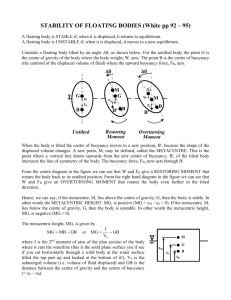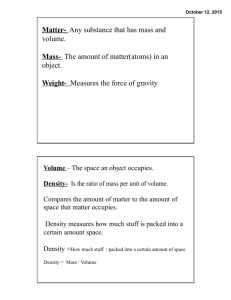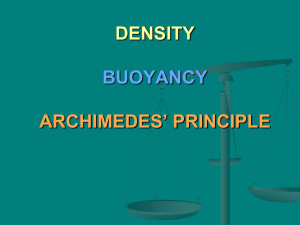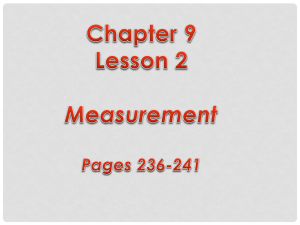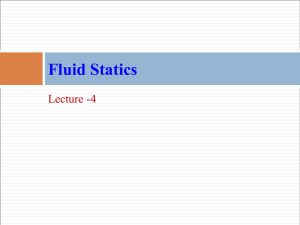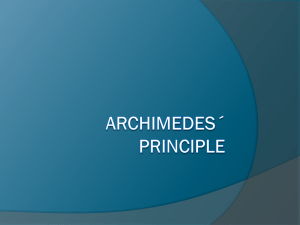Floating Body Stability: Metacentric Height & Buoyancy
advertisement
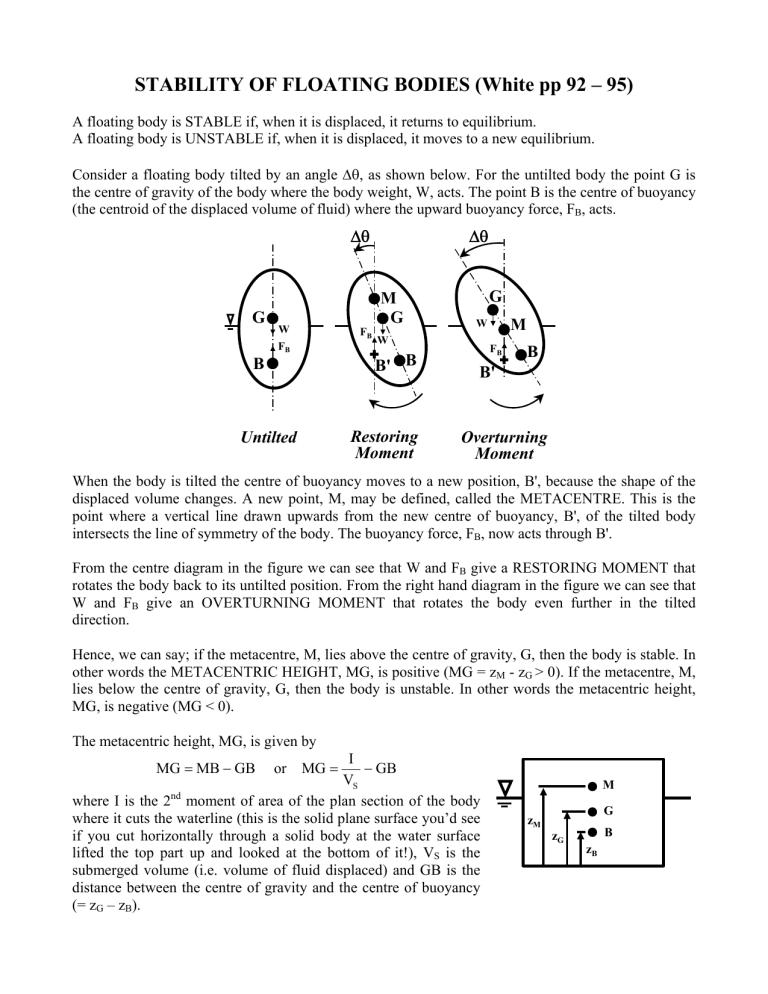
STABILITY OF FLOATING BODIES (White pp 92 – 95) A floating body is STABLE if, when it is displaced, it returns to equilibrium. A floating body is UNSTABLE if, when it is displaced, it moves to a new equilibrium. Consider a floating body tilted by an angle Δθ, as shown below. For the untilted body the point G is the centre of gravity of the body where the body weight, W, acts. The point B is the centre of buoyancy (the centroid of the displaced volume of fluid) where the upward buoyancy force, FB, acts. Δθ Δθ QM GQ QG W FB FB G Q W W ® B' QB BQ Restoring Moment Untilted QM FB Q B ® B' Overturning Moment When the body is tilted the centre of buoyancy moves to a new position, B', because the shape of the displaced volume changes. A new point, M, may be defined, called the METACENTRE. This is the point where a vertical line drawn upwards from the new centre of buoyancy, B', of the tilted body intersects the line of symmetry of the body. The buoyancy force, FB, now acts through B'. From the centre diagram in the figure we can see that W and FB give a RESTORING MOMENT that rotates the body back to its untilted position. From the right hand diagram in the figure we can see that W and FB give an OVERTURNING MOMENT that rotates the body even further in the tilted direction. Hence, we can say; if the metacentre, M, lies above the centre of gravity, G, then the body is stable. In other words the METACENTRIC HEIGHT, MG, is positive (MG = zM - zG > 0). If the metacentre, M, lies below the centre of gravity, G, then the body is unstable. In other words the metacentric height, MG, is negative (MG < 0). The metacentric height, MG, is given by I − GB VS where I is the 2nd moment of area of the plan section of the body where it cuts the waterline (this is the solid plane surface you’d see if you cut horizontally through a solid body at the water surface lifted the top part up and looked at the bottom of it!), VS is the submerged volume (i.e. volume of fluid displaced) and GB is the distance between the centre of gravity and the centre of buoyancy (= zG – zB). MG = MB − GB or MG = zM zG Q M Q G Q B zB Strategy for solving buoyancy problems (1) From geometry of body and density of fluid and body equate; Weight of displaced fluid = Total weight of body. This gives the depth of immersion of the body or the weight of the body, whichever is unknown. (2) To assess stability, first find the location of the centre of gravity G of the body. (3) Then, find the location of the centre of buoyancy B (centroid of displaced volume). For a regularly shaped body this will be at half the height of the immersed portion of the body. (4) Calculate the distance GB. (5) Calculate MB, using MB = I / VS. Note I = π D4/64 for a circular section body and bd3/12 for a rectangular section body (D is diameter, b and d are the sides of the rectangle). (6) Calculate metacentric height, MG (= zM – zG), from MG = MB – GB. If MG > 0 then body is stable. If MG < 0 then body is unstable. Example A solid cylindrical pine (SG=0.5) spar buoy has a cylindrical lead (SG=11.3) weight attached as shown. Determine the equilibrium position (i.e. depth of immersion) of the buoy in seawater (SG=1.03). Calculate the metacentric height and show that the buoy is stable. Weight of fluid displaced = Weight of body γ = Spec. weight of fresh water D = 0.61m x d A 1.03 γ = 0.15 A 11.3 γ + 4.88 A 0.5 γ where A = π D2 /4 x' Pine 4.88m Lead 0.15m d Hence, d = 4.01 m z Find centre of gravity of complete buoy by taking moments of the weight about the base (O): O x x' I xx = π D4 64 GO = zG = 0.15 A 11.3 γ (0.15/2) + 4.88 A 0.5 γ (4.88/2 + 0.15) = 1.56 m 0.15 A 11.3 γ + 4.88 A 0.5 γ Centre of buoyancy (BO) will be at half the height of the submerged part of the body (i.e. half the height of the displaced volume). Hence, BO=zB=d/2 = 2.00m. π D4 2 I 64 = D = 5.8x10−3 m = = MB GB = GO – BO = 1.56 – 2.00 = -0.44 m 16 d VS π D 2 d 4 -3 Therefore, metacentric height MG = MB – GB = 5.8x10 - -0.44 = 0.45 m . MG > 0, hence, stable. Now, think about how much longer the pine section of the buoy would have to be in order for it to become unstable? If the buoy is stable when MG > 0 and unstable when MG < 0, we can say that the limit between being stable or unstable is when MG = 0. In this case MB = GB. If you do the problem again, setting the length of the pine section as L (instead of 4.88m), and equating MB = GB, you can solve for L (by trial and error) to give the maximum length before instability sets in. Try it and see! [Answer = 7.20 m].
